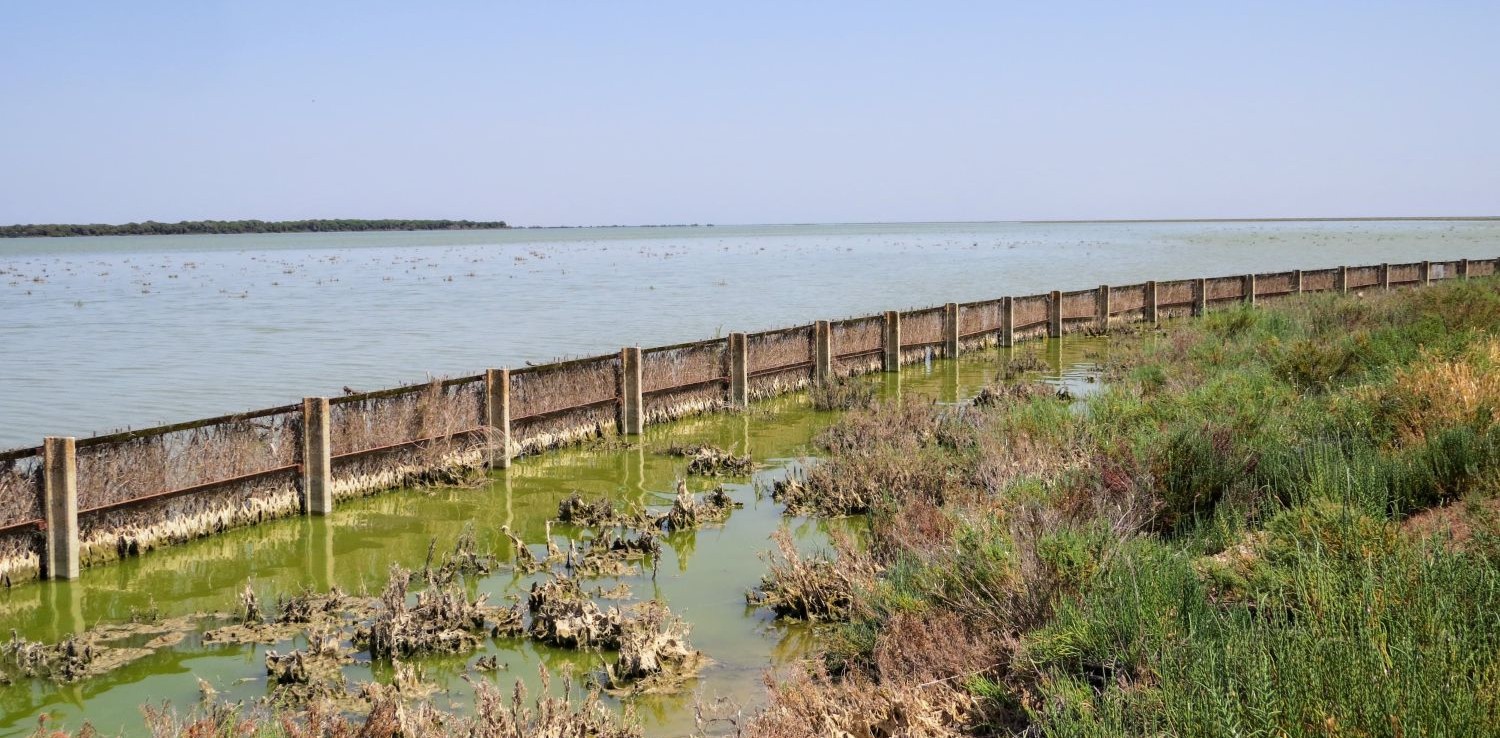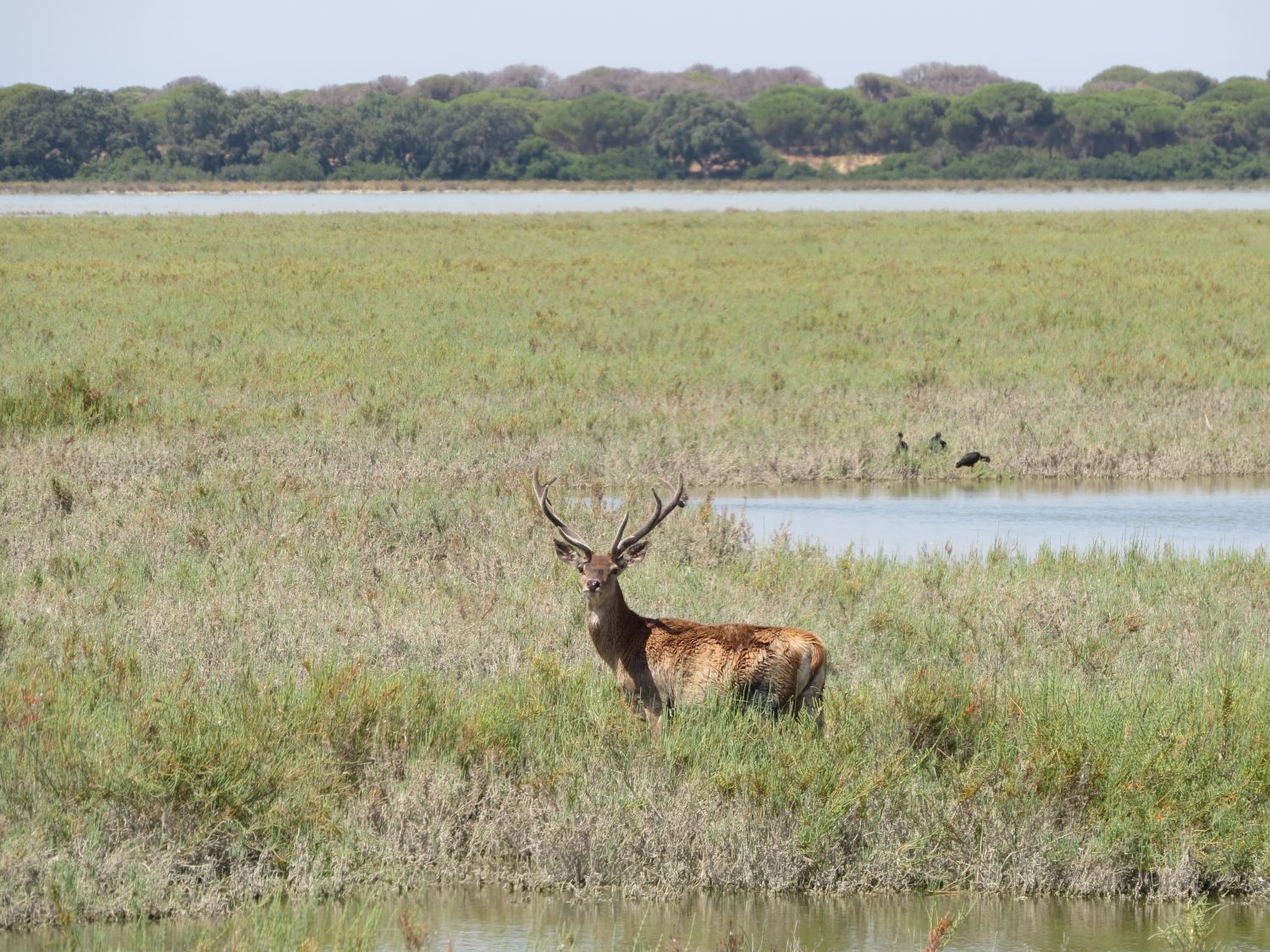Doñana enters summer with exceptional marshland flooding
- This prolonged inundation will benefit waterbird breeding and vegetation regeneration but also presents challenges, such as the spread of invasive species and cyanobacteria.
- Despite this season’s rains, temporary ponds remain at risk due to aquifer overexploitation, highlighting the urgent need for long-term conservation efforts

View of Doñana’s marshlands from the Vereda de Sanlúcar, July 2. Photo: J. Manuel Vidal Cordero
Heavy rains in early 2025—especially in March—have returned Doñana to a state not seen in over a decade. According to historical data from the Doñana Biological Station (EBD-CSIC), the current hydrological cycle is being exceptional, not so much because of the total rainfall but - with around 150 mm above the annual average, but because most of it fell in late winter and early spring. With 287.8 mm of rain, March 2025 was the wettest March since the 1970s, according to data from the weather station at the Doñana Palace. In just six weeks, the flooded surface of the marsh jumped from 7.9% to 97.4%—a figure not reached since 2010.
While the rainfall has revitalized ecosystems directly dependent on rainwater, such as the marsh, years of drought and aquifer overexploitation mean that some priority habitats for conservation, like Doñana’s temporary ponds, will require a much slower recovery process.
Inundación de la marisma
The current hydrological year, which runs from September 2024 through August 2025, began relatively dry until December. The first rains came on October 12, activating the system, but significant flooding didn’t occur until late November, when cumulative rainfall reached 177.5 mm—enough to hydrate the clay soils and begin marsh inundation.
However, December was particularly dry, and the flooded surface receded. The water low water cover reached in November -approximately 15%- progressively decreased to reach a minimum of 7.9% by December 29, according to the Landsat Automatic Image Protocol from the GIS and Remote Sensing Lab at the Doñana Biological Station.
This low level of flooding at the beginning of the year had an impact on the January aerial waterbird census, which showed a figure of just 178,989 individuals, the third lowest recorded for this month in the last 25 years for this type of census, reflecting the poor water conditions at this time.
Significant rainfall finally arrived in late January. On the 21st, the cycle's highest daily rainfall—40.5 mm—was recorded. During the following days, rain continued to fall at a more moderate rate, which boosting the inundation surface to 67,8% by January 30.
The recovery that began in January was significantly reinforced during March, which recorded the highest rainfall of the current hydrological cycle. With 287,8 mm of accumulated precipitation, it became the wettest March in the entire historical series. This steady, moderate rainfall allowed the marshland system to become almost fully reactivated. On 19 March, the Doñana marshes reached their maximum flooding during the cycle, with just over 33,000 hectares flooded, representing 97,4% of their capacity.
Unusually, this flooding has persisted longer than normal. By the end of May, approximately 70% of the marsh remained flooded. As of June 29, satellite imagery from Sentinel-2 shows that around 16,000 hectares are still under water—equivalent to 47% of the total area.
Two main facts may explain this persistence. First, most rainfall came late in the season, in late winter and early spring. Second, these late rains sustained the water supply from the streams running into the marshes until very recently.
Additionally, this is only the second second cycle with such intense rainfall since the marsh was isolated from the estuary after the Aznalcóllar disaster in 1998, when the Montaña del Río dam was built. “This dike connected earlier northern and southern embankments and completely sealed off the Brazo de la Torre marsh from the Guadalquivir River,” explains Diego García Díaz, GIS and Remote Sensing technician at the Doñana Biological Station. “It helped contain toxic spill but also increased the marsh’s water retention capacity.”
In addition to all this, the rainfall across the Guadalquivir basin has raised river levels. Combined with spring high tides, this has made it harder for the marsh to discharge excess water quickly.
This prolonged wet phase is expected to boost waterbird breeding—results will be available in the coming months. However, it may also promote less desirable ecological effects, such as the spread of invasive species like the aquatic fern Azolla and several exotic fish species, as well as cyanobacteria. These are being closely monitored due to their potential impact on water quality and biodiversity.

Temporary ponds
Despite these positive trends observed in the marshes, Doñana’s temporary ponds remain in a more precarious state. These seasonal wetlands are of high ecological value and are listed by the European Union as priority conservation habitats. Their seasonal nature supports unique biodiversity adapted to Mediterranean flood-drought cycles, and they are vital breeding and feeding grounds for many protected aquatic species.
These ponds depend heavily on the underground aquifer, which recharges slowly as rainwater infiltrates the soil. Only when the water table rises high enough to reach the surface, do ponds flood for enough long periods. Since 2020, however, the aquifer has been officially classified as overexploited. In some areas, the water table has dropped as much as 20 meters, causing many ponds that existed only a few decades ago to disappear and threatening the survival of many others.
During the current hydrological cycle, the maximum number of flooded ponds was recorded during the flood peak in March, with 220 detected out of a potential maximum of approximately 400 identifiable by this satellite image analysis. However, the persistence of ponds throughout the spring has been constant. At the end of May, there were around 150 flooded ponds. Currently, there are 54. The remaining temporary ponds are expected to dry up as temperatures rise.
With regard to the larger ponds, once considered permanent, such as Dulce and Santa Olalla, the situation continues to be worrying. Santa Olalla, emblematic for being the largest in the natural area, has dried up for three consecutive cycles, an unprecedented event signalling serious deterioration of Doñana's water system. This critical situation has caused the limits of the pond, already reduced over the last few decades, to be occupied by terrestrial vegetation, a process that is leading to its disappearance, as has already happened with many other ponds. Whether Santa Olalla retains water this summer will depend on the evolution of the weather and the state of the aquifer, factors that continue to be actively monitored.
The significance of this hydrological cycle
This year’s abundant rainfall has been a relief for Doñana’s ecological balance. The natural renewal of the marshes has been supported by the restoration of the full flood-and-dry cycle—an essential process for sustaining the biodiversity of this unique place.
The start of the hydrological cycle was concerning, but rainfall concentrated in the second half of winter, combined with favorable spring conditions, has allowed for the expansion and persistence of water in the marshes—conditions that will support waterbird breeding and the regeneration of characteristic vegetation. However, the prolonged flooding also poses challenges, such as the spread of invasive species and cyanobacteria, whose development must be carefully monitored to minimize potential negative impacts on water quality and biodiversity.
On the other hand, the critical state of the underground aquifer continues to limit the full recovery of other key ecosystems within the Park, such as the temporary ponds. These habitats, which depend on a sufficiently high water table to flood, are still suffering the effects of overexploitation and prolonged drought in recent years—putting their ecological function and associated biodiversity at serious risk. The limited number of water-filled bodies observed this year underscores that, despite the season's rainfall, recovery of the hydrological system will be a slow process requiring management measures aimed at ensuring the long-term sustainability of both the aquifer and the habitats it supports.
In conclusion, while this hydrological cycle presents a valuable opportunity for surface water ecosystems, it must not overshadow the critical situation of the aquifer and temporary ponds—whose restoration will depend on sustained, long-term action.